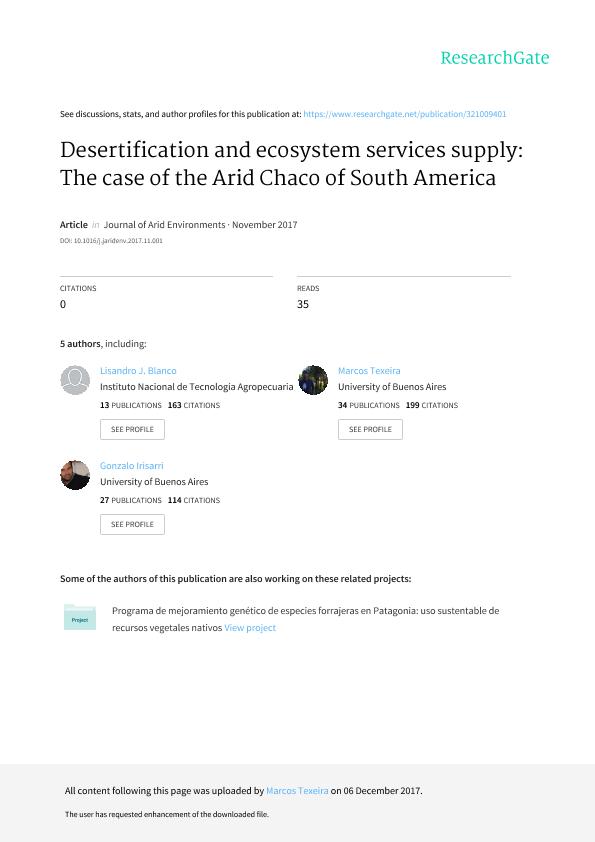Artículo
Desertification and ecosystem services supply: The case of the Arid Chaco of South America
Verón, Santiago Ramón ; Blanco, Lisandro Javier; Texeira González, Marcos Alexis
; Blanco, Lisandro Javier; Texeira González, Marcos Alexis ; Irisarri, Jorge Gonzalo Nicolás
; Irisarri, Jorge Gonzalo Nicolás ; Paruelo, José
; Paruelo, José
 ; Blanco, Lisandro Javier; Texeira González, Marcos Alexis
; Blanco, Lisandro Javier; Texeira González, Marcos Alexis ; Irisarri, Jorge Gonzalo Nicolás
; Irisarri, Jorge Gonzalo Nicolás ; Paruelo, José
; Paruelo, José
Fecha de publicación:
12/2017
Editorial:
Academic Press Ltd - Elsevier Science Ltd
Revista:
Journal of Arid Environments
ISSN:
0140-1963
Idioma:
Inglés
Tipo de recurso:
Artículo publicado
Clasificación temática:
Resumen
New integrated perspectives are increasingly needed to bridge the gap between biophysical and ecosystem services' based assessments of desertification. For a vast area of the dry Chaco region we sought to: (1) assess the spatial extent of four syndromes of vegetation change, associated with human or climatic drivers and (2) estimate and compare the supply of ecosystem services among these syndromes. We used a remote sensing approach based on the growing season -October to March- normalized difference vegetation index from MODIS, and climatological datasets from 2003 to 2013 to estimate: i) precipitation use efficiency, ii) precipitation marginal response, iii) the temporal trends of the residuals from the normalized difference vegetation index - annual precipitation linear relationship, and iv) the ecosystem services provision index. We diagnosed vegetation syndromes based on the difference between actual and reference sites' precipitation use efficiency and precipitation marginal response. Negative residuals trends were interpreted as vegetation changes driven by inadequate human management. The ecosystem services provision index assumes that ecosystem services supply varies positively with primary production and a negatively with its seasonal variability. Our results showed that 9.1% of the observed area belonged to the vegetation improvement syndrome - positive Delta precipitation use efficiency and Delta precipitation marginal response - while 3.4% were classified as vegetation cover reduction -negative Delta precipitation use efficiency and Delta precipitation marginal response. In turn, 10.5% and 2% of the study area fell within the increment in herbaceous vegetation -negative Delta precipitation use efficiency and positive Delta precipitation marginal response - and woody encroachment syndromes - positive precipitation use efficiency and negative precipitation marginal response - respectively. Human management did not have a uniform impact as all 4 syndromes displayed positive and negative residuals trends. Contrary to our expectations, there was no apparent association between vegetation syndromes and the supply of ecosystem services as estimated by the ecosystem services provision index. This study serves as a prototype to remotely assess ecosystem properties indicative of different vegetation syndromes and the associated supply of ecosystem services in dryland regions.
Archivos asociados
Licencia
Identificadores
Colecciones
Articulos(IFEVA)
Articulos de INST.D/INV.FISIOLOGICAS Y ECO.VINCULADAS A L/AGRIC
Articulos de INST.D/INV.FISIOLOGICAS Y ECO.VINCULADAS A L/AGRIC
Citación
Verón, Santiago Ramón; Blanco, Lisandro Javier; Texeira González, Marcos Alexis; Irisarri, Jorge Gonzalo Nicolás; Paruelo, José; Desertification and ecosystem services supply: The case of the Arid Chaco of South America; Academic Press Ltd - Elsevier Science Ltd; Journal of Arid Environments; 12-2017
Compartir
Altmétricas



